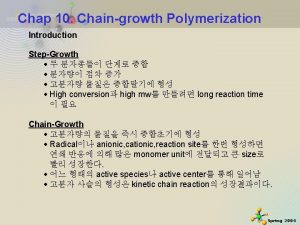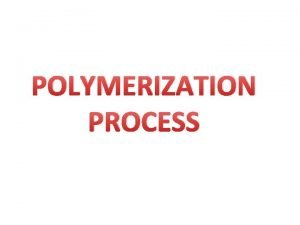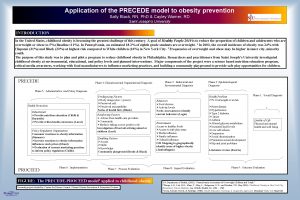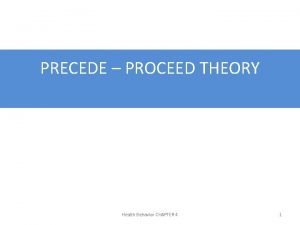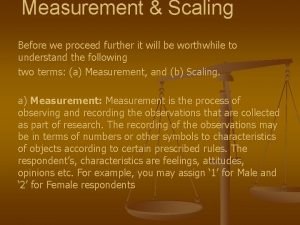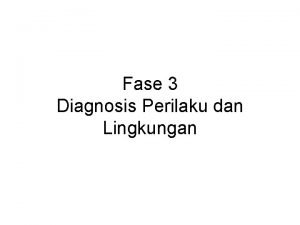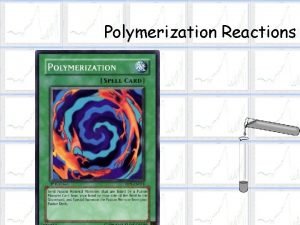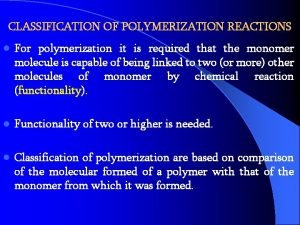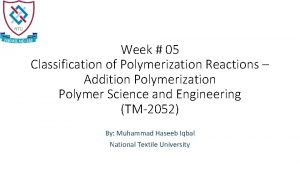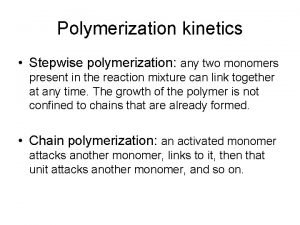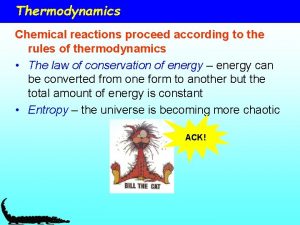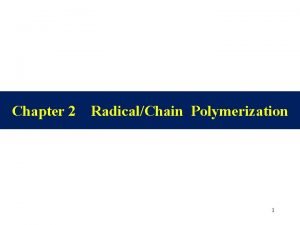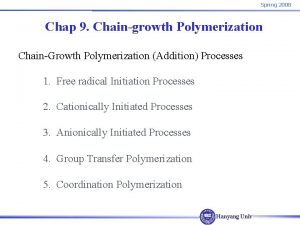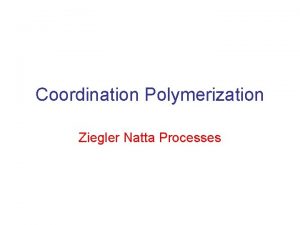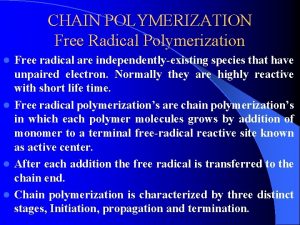POLYMERIZATION REACTIONS Polymerization can proceed according to two













- Slides: 13

POLYMERIZATION REACTIONS Polymerization can proceed according to two different mechanisms, referred to as chain-growth and step-growth polymerization.

Step-growth polymerization Step-growth polymers, also called condensation polymers. This type of polymers is generated by the condensation of two monomer units with the loss of small molecules such as H 2 O, HCl, and NH 3 etc. Here the monomer units must have two functional groups in order to condensation reaction takes place.

The polyester and the polyamide Nylon 66, shown here, are two examples of synthetic condensation polymers, also known as step-growth polymers. Ref: http: //chemistry. elmhurst. edu/vchembook/402 condensepolymers. html


Chain-Growth (Addition) Polymerization Addition polymers are formed by the sequential addition of the monomer units with the help of a reactive intermediate such as free radicals, cation or anions without loss of small molecules. The addition polymerization generally involves three steps called initiation, propagation and termination. These steps apply to all types of addition polymerization such as freeradical, cation and anion. In this process alkenes are typically used as monomers and polymerization results by successive additions across the double bonds.

Radical Chain-Growth Polymerization When radical polymerization is desired, it must be started by using a radical initiator, such as a peroxide or certain azo compounds. The formulas of some common initiators, and equations showing the formation of radical species from these initiators are presented below.

One example of radical polymerization is the conversion of styrene to polystyrene. The first two equations illustrate the initiation process, and the last two equations are examples of chain propagation. https: //www 2. chemistry. msu. edu/faculty/reusch/Virt. Txt. Jml/mechism/polvincl. htm

In principle, once started a radical polymerization might be expected to continue unchecked, producing a few extremely long chain polymers. In practice, larger numbers of moderately sized chains are formed, indicating that chain-terminating reactions must be taking place. The most common termination processes are Radical Combination and Disproportionation. Note that in both types of termination two reactive radical sites are removed by simultaneous conversion to stable product(s). Since the concentration of radical species in a polymerization reaction is small relative to other reactants, the rate at which these radical-radical termination reactions occurs is very small, and most growing chains achieve moderate length before termination.

Another reaction that diverts radical chain-growth polymerizations from producing linear macromolecules is called chain transfer. As the name implies, this reaction moves a carbon radical from one location to another by an intermolecular or intramolecular hydrogen atom transfer. Further polymerization at the new radical site generates a side chain radical, and this may in turn lead to creation of other side chains by chain transfer reactions. Chain transfer reactions are especially prevalent in the high pressure radical polymerization of ethylene, which is the method used to make LDPE (low density polyethylene). As a result, LDPE is composed of highly branched macromolecules.

Cationic Polymerization


Anionic Polymerization

The Chain That Wouldn't Die This process doesn't stop! In many cases, the only thing that stops monomers from adding to the growing chain, is that eventually there are no more monomer molecules in the beaker left to add! And even then, if someone came along some time later and dumped more monomer into the beaker, they would add to the chain and the chain would grow some more! Some chains of polystyrene have been known to stay active like this for years. In order to stop them, something like water, which reacts with the carbanions, has to be added to the polymer. Systems like this are called living anionic polymerizations.
 Step polymerization vs. chain polymerization
Step polymerization vs. chain polymerization Bulk polymerization
Bulk polymerization Section 2 reinforcement classifying chemical reactions
Section 2 reinforcement classifying chemical reactions Reduction half reaction
Reduction half reaction Section 2 classifying chemical reactions worksheet answers
Section 2 classifying chemical reactions worksheet answers Types of reactions
Types of reactions Unit 5 chemical reactions answers
Unit 5 chemical reactions answers Pengertian precede proceed
Pengertian precede proceed Precede-proceed model example obesity
Precede-proceed model example obesity Precede proceed model
Precede proceed model Luxman k-115
Luxman k-115 Before we proceed further
Before we proceed further Diagnosis perilaku dan lingkungan
Diagnosis perilaku dan lingkungan Applications of trigonometry in navigation
Applications of trigonometry in navigation
